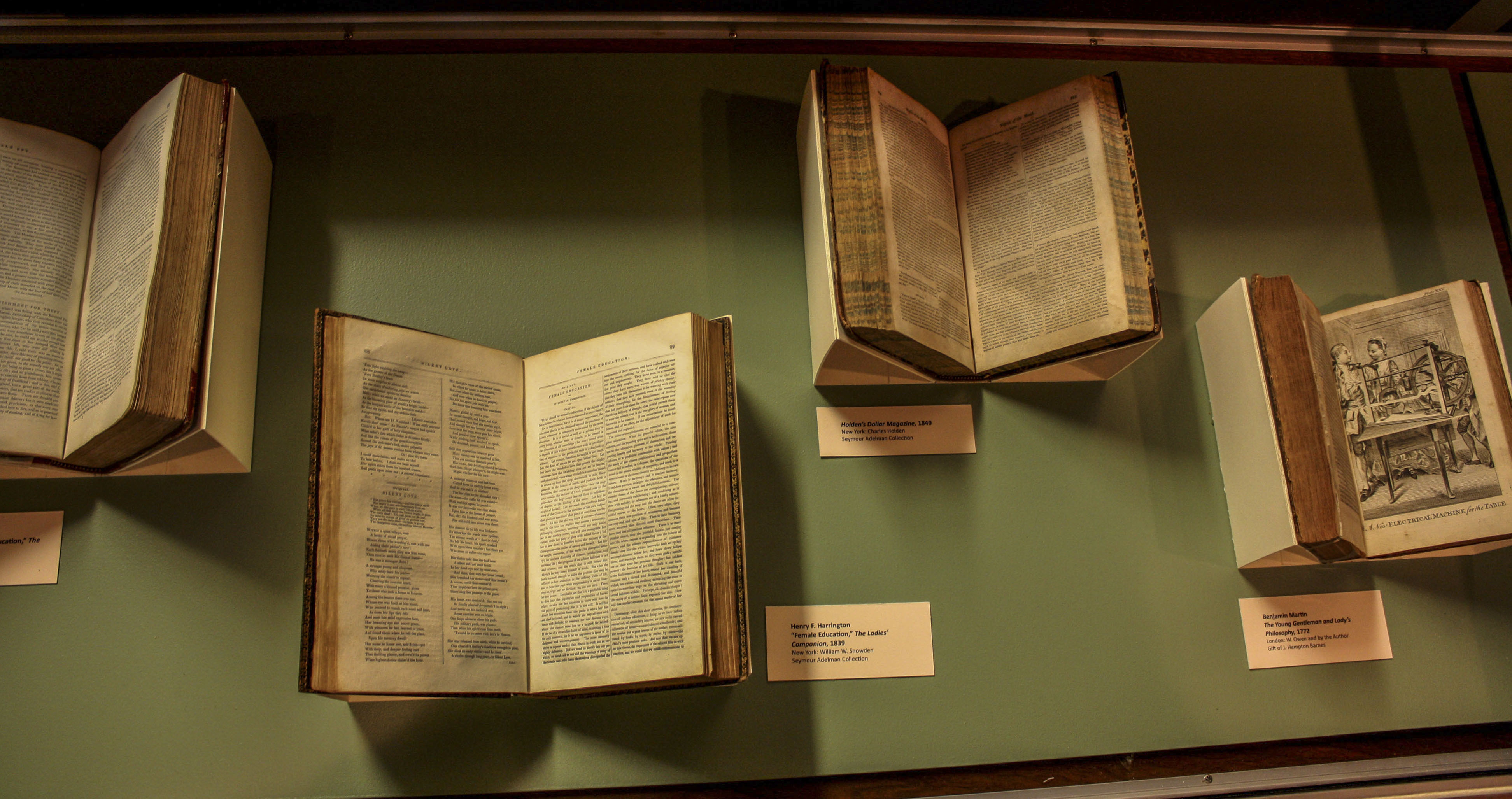Tag Archives: Project related events
#ProjectPerry Preview: Tuesday, January 27 at 4pm

The Relaunching Perry House Committee has been meeting since the fall, and we’re excited to gather on campus this afternoon to share a preview of plans for its reopening, slated for the next academic year.
Details and RSVP here.
Interested in learning more? Earlier this week, committee member Khadijah Seay, Bryn Mawr College Class of 2016, shared some thoughts on her blog, Life at the Mawr.
On the history of Perry House, visit “A Point of Difference: Diversity at Bryn Mawr College,” the digital exhibition created by Alexis de la Rosa, Bryn Mawr College Class of 2015, and Lauren Footman, Bryn Mawr College Class of 2014. Their research provides both the historical context of what was originally designed as a black cultural center at Bryn Mawr College, and highlights some of the original correspondence on the matter between students and administrators in the early 1970s.
As a member of the subcommittees on programming and library space, I’m particularly interested in how we collect the history of Perry House, build on that history, and imagine a vibrant future for the space.
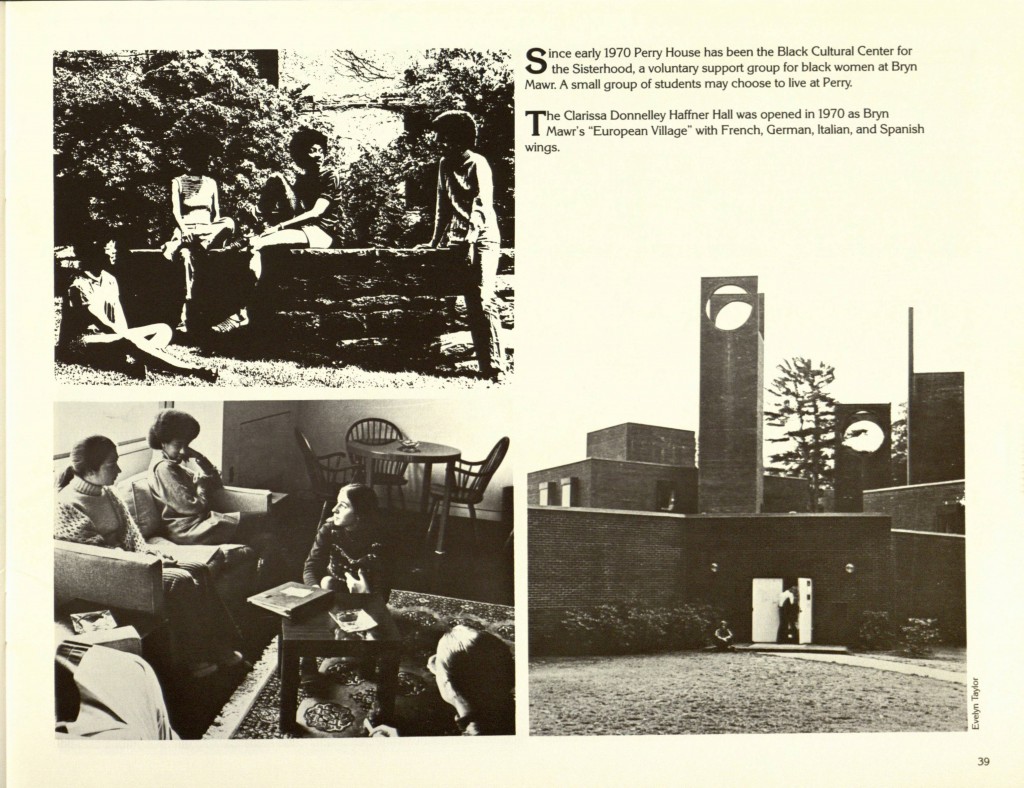
Bryn Mawr College brochure, 1985. See the complete document on Triptych.
One of the things we’ll be discussing in the coming months is the future of the Perry House library, which officially opened in September 1989. As we know from other explorations of campus history, Bryn Mawr College students have often been library builders.
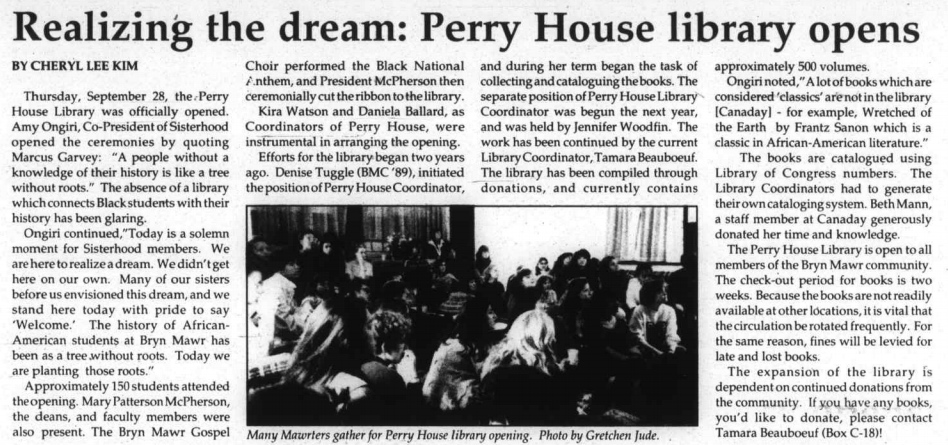
“Realizing the dream” in The College News, September 1989. Read the article here.
The Relaunching Perry House Committee looks forward to collecting community input, as well as reaching out to alumnae/i in the next few months. One way to connect with us is on Twitter: #ProjectPerry. A full list of committee members is online, with plans for a blog coming soon. Thoughts? Memories? Connect with us in the comments below.
“Proper Study for Ladies” and other gems that didn’t make it into Taking her Place
When we were collecting material for the exhibition Taking Her Place, it was a challenge to find items that would tell the story of women’s ascent into higher education without relying too heavily on only text. Periodicals such as The Ladies’ Companion and The Ladies Garland are some of the best resources that we have for gauging society’s attitude towards female intellectualism, as the articles they featured show the developing shape of public opinion. However, they do not make ideal exhibit items: arranged behind glass, the books are difficult or impossible to read at length, and an exhibition dominated by unreadable books makes for a bland visual display. Therefore, we found ourselves with many fascinating textual objects that illustrated the story we wanted to tell but did not have a place in the exhibition. Many of those items hold an important place in the narrative of women’s rise into the public sphere, and as we move into the final week of the exhibition, we will highlight a few of them on this blog in order to more fully flesh out the themes that we address in that space. We will post more material in conjunction with the release of an online version of the exhibition, which will take the form of a digital exhibit like the others on our website.
One item that we would have like to include is this article from an 1839 issue of The Ladies’ Garland, entitled “Proper Studies for Ladies,” which touches on many of the themes common to the opinion pieces of the era. As higher education for women appeared on the horizon, society grappled with what forms of knowledge would be appropriate for a woman to pursue. In this article, the anonymous male author juxtaposes the intellectual and commercial realms of society and seems to feel dubiously about women’s place in either.
The prevailing message of the piece is that modern women are wont to forgo the enriching study of history and natural philosophy in favor of “fashionable trifles,” “idle romances and puerile tales.” Instead, he writes, ladies “of the first rank” ought to “form their taste upon the best authors, and collect ideas from their useful writings.”
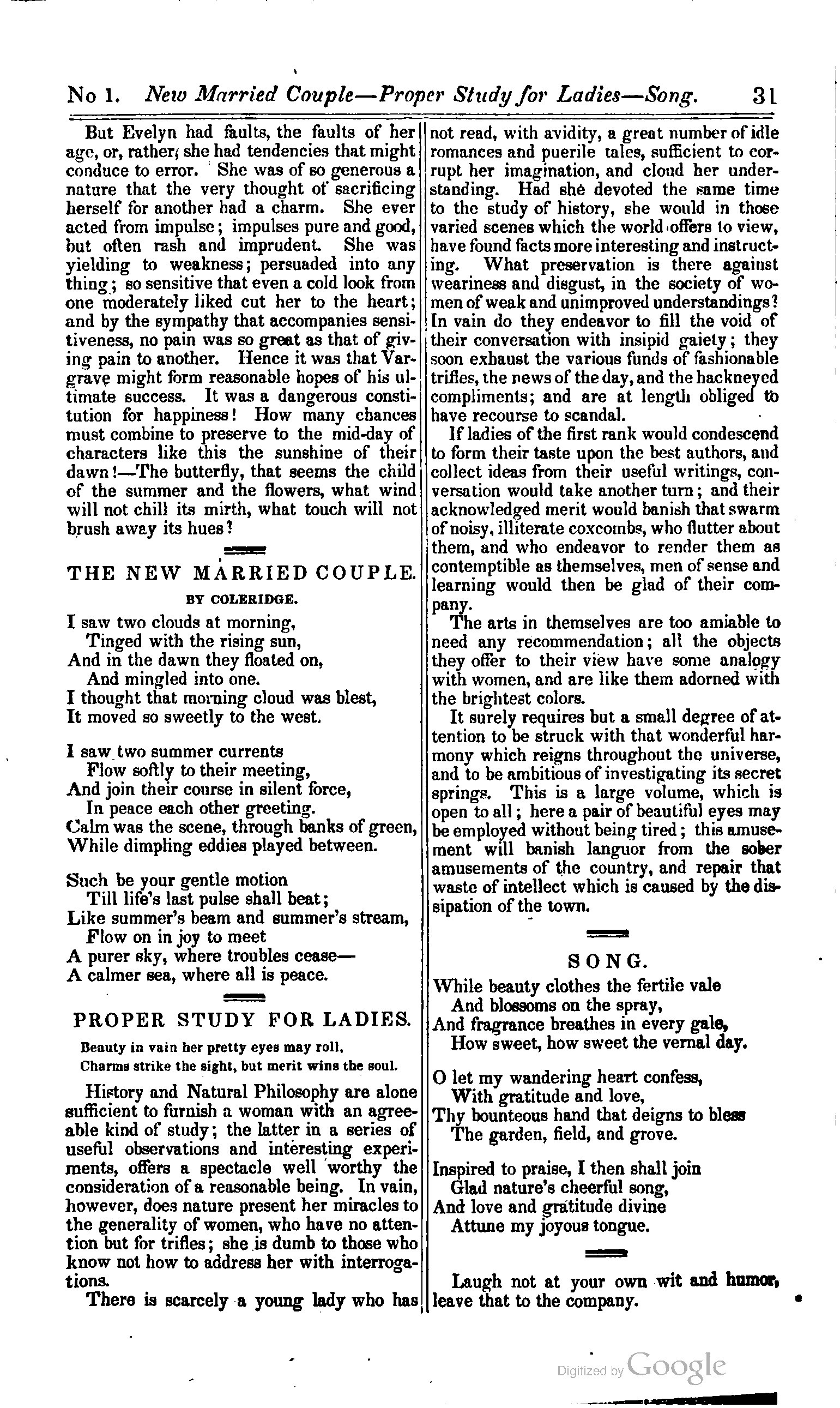
Page 31 of The Ladies Garland, Volume II, 1839, including “Proper Study for Young Ladies.” Click for enlarged view.
While I was combing through contemporary journals and magazines to get a sense public opinion across the era, this piece stood out to me as unusual. It struck me as fairly advanced for 1839 that a male author would take for granted that intellectual study was both available to and appropriate for women. However, though it seems progressive in its advocacy for ladies’ serious study, there is a strong conservatism at its core that I will devote this post to exploring. This paradox is characteristic of many of the articles that Jennifer and I read while researching for the exhibition: I’ve learned that progressivism and conservatism often move together in strange ways as society adjusts to major changes, and are rarely as separable or black-and-white as I would have initially expected to find them.
It fascinates me that the author is certain at such an early date that any woman who wished to could gain access to intellectually stimulating study. “This is a large volume,” he writes of such pursuits, “that is open to all.” However, “In vain…does nature present her miracles to the generality of women,” as if the study of natural science was so available that women would have to work hard not to be exposed to it. It is unclear exactly how he expected them to engage with such material, considering the state of formal schooling at the time: Oberlin College, the first co-educational college in the United States, had been founded only six years earlier, in 1833. The only other form of secular post-secondary education for women at the time was the seminaries that offered training for a teaching career, of which there were eight in existence nationwide in 1839. Since formal higher education was hardly widespread, the author therefore seems to imagine that women should be pursuing academic curiosity in a self-guided capacity.
Writers of a previous age, and many who wrote well into the 1800s, considered the education of a woman to be tantamount to her corruption. This author clearly disagrees, but if a woman of virtue could be an intellectual, what sort was she to be and to what end was she to use her sophistication? A hint can be found at the very beginning of the piece, in the epigraph:
“Beauty in vain her pretty eyes may roll,
Charms strike the sight, but merit wins the soul.” [1]
This quotation frames the article by asserting the value of substance over appearance, which is consistent with the article’s rejection of ornament—but, notably, it also situates the matter within the context of women’s appeal to others: it lays groundwork for an article that will posit female intellectualism as a tool for attraction; in short, another form of ornament.
The author’s thesis is that because they fail to take advantage of the intellectual richness available to them, most women thus reduce their prospects for good matches by offering only conversation which is vapid and unappealing to respectable men—who are, of course, the true victims of this unfortunate situation. “What preservation is there against weariness and disgust,” he ruminates, “in the society of women of weak and unimproved understandings? In vain do they endeavor to fill the void of their conversation with insipid gaiety; they soon exhaust the various funds of fashionable trifles, the news of the day, and the hackneyed compliments; and are at length obliged to have recourse to scandal.” The true goal, therefore, of women’s learning, is to make them into better companions.
The article suggests that the idea of what would corrupt women was changing. The previous belief was that knowledge itself would corrupt, whereas here it is the wrong kind of knowledge that is to be feared—In other words, a misuse of intellectual powers. Indeed, language of misuse, in the form of waste and misdirected spending, permeates the piece. Three examples come to mind: the phrase “in vain” appears three times including the epigraph, each instance describing a woman (if we count the personified Nature) fruitlessly expending effort in order to appeal to another. The unlearned lady whose foolish prattle fails to impress “soon exhaust[s] the various funds of fashionable trifles.” (Italics mine.) And, at the end of the article, the author bemoans the “waste of intellect which is caused by the dissipation of the town.” Instead of such wasteful behavior, he suggests that women “collect” (ideas from the best authors) rather than spend. This language underlies his portrayal of women consumed with the trivial trappings of femininity, especially those that could be linked to commercialism and had an air of cheapness: they were attracted to the “fashionable trifles” that were being marketed to them (in magazines just like this one), and even their trivial conversation (“the news of the day,” “scandal,”) is ephemeral and probably harvested from the gossip columns.
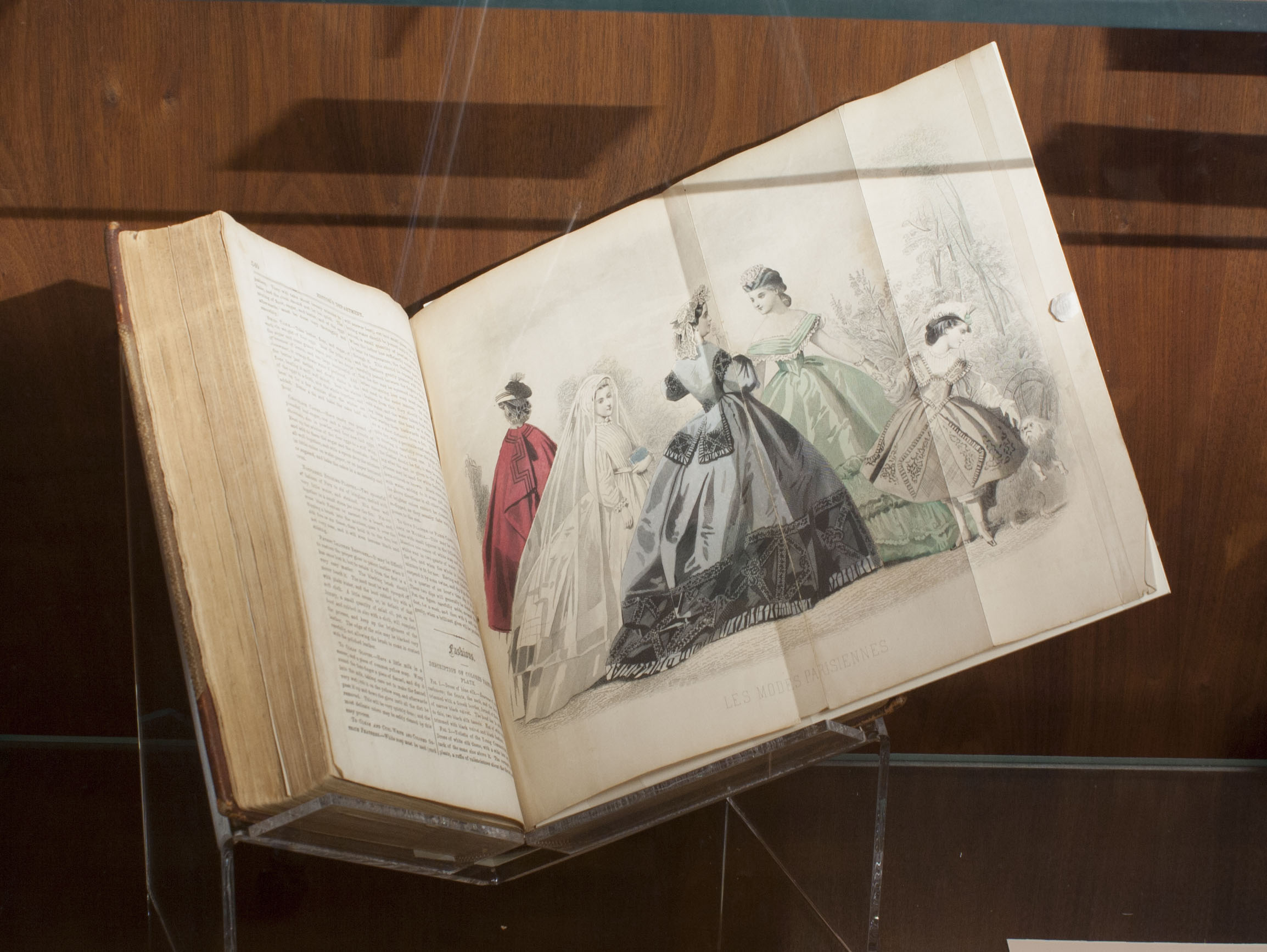
The Ladies’ Friend, another popular periodical at the time, interspersed fiction and opinion pieces with large pull-outs like this one depicting the fashions of the season.
Considering all of the negative associations that he establishes between women and commercial economy, perhaps the feminine ideal that the author paints (studious, yet passive, and economically disengaged) is a paranoid reaction to women’s growing economic power as a class of consumers. He manages to exclude women from both the commercial and intellectual realms: he blames them for partaking in the former, and suggests that they would be welcome in the latter if only they had the virtue to earn themselves a place there. And do they? He writes that “scarcely a young lady” exists who has not fallen into the pitfalls of cheap and entertaining literature. Though he idealizes the woman who devotes her time to academic study, he speaks of such women as if they are in practice an impossibility, a mythical being. Women’s real practices are demonized, and the hypothetical woman who “gets it right,” so to speak, doesn’t exist: perhaps he is so threatened by female agency that he is compelled to write them out of all public realms. So, if they can exist productively nowhere in the public sphere, what use are women to society? The one role that the author feels comfortable ascribing to women is that of passive indicator of the state of society. He ends with the proclamation that the “amusement [of proper study] will…repair that waste of intellect which is caused by the dissipation of the town,” as if women’s unintellectualism is a symptom of a societal disease. He implies that the health of society can be read through the quality and state of its women, positing them as a kind of diagnostic tool rather than as a class of people.
This article, one of many that we would have liked to include more prominently in Taking Her Place, demonstrates several themes that are common to the opinion articles of the age. It shows a surprisingly advanced advocacy for women’s learning, while still clinging rigidly to the traditional role of the subordinate an ornamental woman. It also conspicuously lacks an argument for education for its own sake: it was much more common to posit education as a means to serve some aspect of traditional femininity, such as aptitude for motherhood or (as seen here) male companionship. The juxtaposition of commercial and intellectual pursuits was also a major topic of writings of the time, especially with an air of blame towards any woman who demonstrated too much affinity for the former. Combing through these books and journals was a fascinating activity and gave us a broad sense of the complexity of changing opinion across an era. Anybody who is interested in learning more, or in reading other articles from our wide collection, is encouraged to come visit in Bryn Mawr Special Collections in Canaday Library and browse the collection for themselves.
[1]Though uncredited and misquoted, the lines are from Alexander Pope’s “The Rape of the Lock,” first published in 1712. The first line in the original text reads “Beauties in vain their pretty eyes may roll.”
Women’s History in the Digital World – March 22nd to 23rd 2013
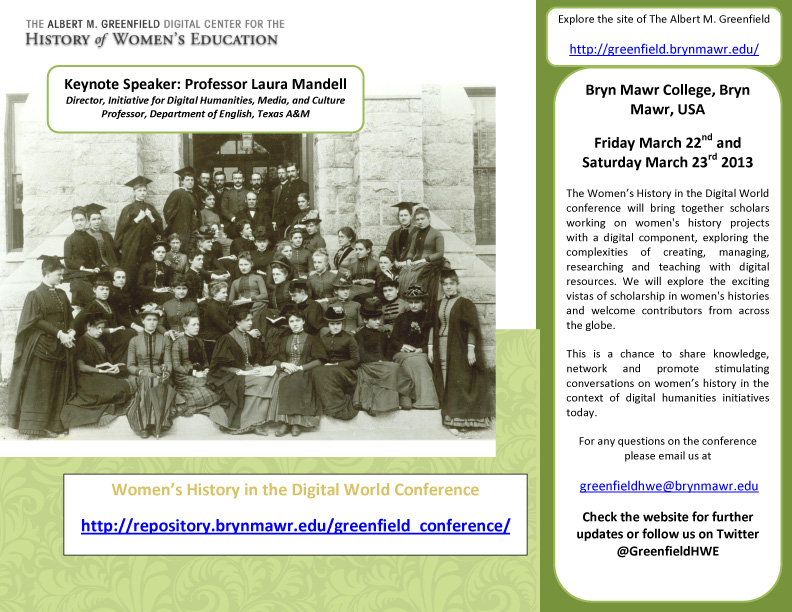 It’s almost time for the inaugural conference of The Albert M. Greenfield Digital Center for the History of Women’s Education!
It’s almost time for the inaugural conference of The Albert M. Greenfield Digital Center for the History of Women’s Education!
Women’s History in the Digital World offers a packed schedule of digital humanities projects that focus on women’s history. Participants are coming from across the US and the world to showcase their work, share information on tools, research, funding and practices, and most of all, meet each other in an environment wholly dedicated to women’s history issues in the digital era. Members of The Albert M. Greenfield Digital Center for the History of Women’s Education and its Advisory Board members will be in attendance to inform you about our work and our future plans.
Our keynote speaker, Laura Mandell is Director of the Initiative for Digital Humanities, Media, and Culture and Professor of English at Texas A&M University. She is the author of Misogynous Economies: The Business of Literature in Eighteenth-Century Britain (1999), a Longman Cultural Edition of The Castle of Otranto and Man of Feeling, and numerous articles primarily about eighteenth-century women writers, and Breaking the Book (forthcoming). She is Editor of the Poetess Archive, on online scholarly edition and database of women poets, 1750-1900, Director of 18thConnect, and Director of ARC, the Advanced Research Consortium overseeing NINES, 18thConnect, and MESA. Professor Mandell will speak on ‘Feminist Critique vs. Feminist Production in Digital Humanities’.
Registration is open and you must register online if you are planning to attend the conference by going to the registration page of the official conference website. It’s not too late to register! Registration fee is just $30 and this gives you access to the full conference, including the keynote and reception on Friday, all panels, coffee breaks and lunch on Saturday and a special closing reception at the gallery in Canaday Library to see Taking Her Place, 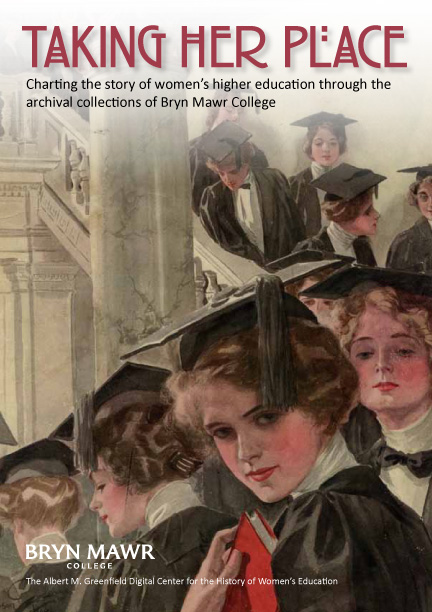 a show curated by The Albert M. Greenfield Digital Center for the History of Women’s Education. This will give conference attendees a final chance to engage with each other, view the collections of Bryn Mawr College, and wind down after a productive and fruitful gathering.
a show curated by The Albert M. Greenfield Digital Center for the History of Women’s Education. This will give conference attendees a final chance to engage with each other, view the collections of Bryn Mawr College, and wind down after a productive and fruitful gathering.
Don’t forget that, as advertised on the official conference website, we are also offering a free tour of campus at 3.30pm on Friday March 22nd before the conference begins. If you would like to attend the tour, please email greenfieldhwe@brynmwar.edu with ‘RSVP Tour’ in the subject line of the email.
Presenters at the conference are offered the ability to upload their presentations and related material to our institutional digital repository so they can be shared afterwards.
Our official conference hashtag is #WHDigWrld so if you’re coming to the conference don’t forget to promoted and follow the conversation using it, and as always, don’t forget to follow us on Twitter @GreenfieldHWE
For any queries about the conference, including registration, please email greenfieldhwe@brynmawr.edu. For specific queries about the work of the Center, please email the Director, Jennifer Redmond, at jredmond@brynmawr.edu
Come join us – we look forward to seeing you!
We are live! Announcing the launch of The Albert M. Greenfield Digital Center for the History of Women’s Education
 The Albert M. Greenfield Digital Center for the History of Women’s Education is proud to announce the official launch of its website! We’ve been in beta for some time now, and while the site continues to grow, we can now proclaim to you all that we are live and ready to receive your comments….
The Albert M. Greenfield Digital Center for the History of Women’s Education is proud to announce the official launch of its website! We’ve been in beta for some time now, and while the site continues to grow, we can now proclaim to you all that we are live and ready to receive your comments….
The past year has been one of exciting growth for The Albert M. Greenfield Digital Center and we are delighted to finally share the fruits of our hard work with you. The website will serve scholars in the US and across the world by providing free, open access to materials on the web related to the history of women’s education. We have digitized a variety of our own resources and built partnerships with other colleges to feature related original sources in their possession. An example of this is our collaboration with Dr. Anne Bruder’s class at Berea College. Dr. Bruder (editor of Offerings to Athena and Advisory Board Member) challenged her class to create a digital exhibit reflecting on the gendered histories of Berea College (the exhibit can be found here).
The website also features thematic exhibits on past alums, such as Margaret Bailey Speer, lesson plans created by Temple University students as part of the Cultural Collaboration Fieldwork Initiative, and current Bryn Mawr undergraduates’ work on the scrapbooks created by students in the early years of the college. We are focusing on digitizing prominent or unique items in our collections which will be freely available for teaching, research or general interest to users across the world.
The Center’s team has been led by Jennifer Redmond, and consists of a number of key members focusing on both the digital and research components of the Center:
- Cheryl Klimaszewski, Digital Collections Specialist in Canaday Library, has continued as the technical lead on the project
- Jessy Brody (BMC ’10), a Digital Assistant on the project, has been heavily involved in the digitization of scrapbooks and research on athletics at Bryn Mawr
- Jen Rajchel (BMC ’11) recently finished her role as Digital Initiatives Intern and is currently the Assistant Director of the Tri-Co Digital Humanities Initiative
- Evan McGonagill (BMC ’10) is a Research Assistant working at the Center, focusing on researching the collections and is in charge of the social media presence of the Center. (Click here to see the Center’s team and click here to see the Advisory Board members).
The work of the Center continues to be overseen by Eric Pumroy, Director of Library Collections and Seymour Adelman Head of Special Collections; and Elliott Shore, Chief Information Officer and Constance A. Jones Director of Libraries and Professor of History.
As part of the launch of the site, we are announcing the second annual essay competition, again kindly sponsored by the Friends of the Library. The theme is ‘Transformations: How has the Bryn Mawr College experience made you the person you are today?’ Further details on the competition can be found here.
Our first exhibition, Taking Her Place, will be hosted in the Rare Book Room gallery in Canaday Library, Bryn Mawr College, from January to June 2013. Given the intense scholarly interest in the lively field of women’s educational history, we feel the exhibition will be a welcome addition to exploring the history of women’s reading, learning, scholarship and their battle to take their education and expertise from the private to the public sphere. It will also be a way to visually narrate the journey many women traveled to achieve their ambitions of becoming learned women.This show will explore women’s worlds of reading, learning, educational attainment and entry into the world of work and the public sphere. The exhibition will be launched by Professor Helen Horowitz, renowned historian of women’s education, biographer of M. Carey Thomas and one of the keynote speakers at the ‘Heritage and Hope’ conference in 2010 which celebrated the 125th anniversary of the founding of the college. Her talk on January 28th 2013 will be on “Reading, Writing, Arithmetic…and Power: Education as Entry to the World”. On Thursday April 18th 2013 Professor Elaine Showalter, Bryn Mawr College class of 1962 and Avalon Foundation Professor Emerita at Princeton University, will also be coming to give a speech as part of the exhibition program. Please check back here for further details on these exciting events. A digital version of the exhibition will be made available online after it closes.
The exhibition is jointly curated by Jennifer Redmond and Evan McGonagill. We are creating ‘Taking her Place’ with the assistance of our colleagues in Special Collections, Eric Pumroy, Brian Wallace, Marianne Hansen, Lorett Treese and Marianne Weldon, with the digital expertise of Cheryl Klimaszewski and Jessy Brody.
Finally, we are also announcing the first Call for Papers ‘Women’s History in the Digital World’, to be held at Bryn Mawr College, Friday 22nd and Saturday 23rd March 2013. We are honored to have as our keynote speaker Professor Laura Mandell, Director of the Initiative for Digital Humanities, Media, and Culture and a Professor in the Department of English at Texas A&M. The conference will bring together scholars working on women’s history projects with a digital component, exploring the complexities of creating, managing, researching and teaching with digital resources. We will explore the exciting vistas of scholarship in women’s histories and welcome contributors from across the globe. This will be the first conference held by us, but hopefully this will become an annual event. We wish to bring together both experienced and newer scholars in the world of digital projects on women. Watch this space for further details!
There will be other public events throughout the Spring so please check back regularly at http://greenfield.brynmawr.edu/ and follow us on Twitter (@GreenfieldHWE). Announcements will be made also through the Friends of the Library Facebook page.
We welcome your feedback on the new site, please leave comments here or else get in touch directly with the Director (jredmond@brynmawr.edu or via Twitter @RedmondJennifer)
Talk in Center City: The Quest to be Educated: the Complicated History of Women and Higher Education, Feb 9th 2012
For any of you interested in hearing more about The Albert M. Greenfield Digital Center and the kinds of research we are engaged in, Bryn Mawr College Friends of the Library in collaboration with New Century Trust are hosting the Director, Jennifer Redmond to speak on ‘The Quest to be Educated: the Complicated History of Women and Higher Education’.
The talk will begin at 5:30 pm and is at the New Century Trust building, 1307 Locust Street, Philadelphia. The New Century Trust is an organization that was founded in 1893 to support the social, industrial and educational cultivation and improvement of working girls and women. For more about the Trust, see http://newcenturytrust.org
At a time when women seem to be outperforming men in many areas of educational achievement, it is difficult to remember that higher education for women was a highly controversial idea just a century ago, and that most elite colleges and universities in America did not admit women until the 1970s. The talk will focus on women’s early struggles to gain access to higher education, the preconceptions of women’s capabilities and roles in society that had to be overcome, and the critical role played by women’s colleges like Bryn Mawr. The activities of the Center will also be announced, including a volunteer transcription project we hope many of you will get involved with.
For additional information about the talk, or to rsvp, please contact the Special Collections Department, Bryn Mawr College Library: SpecColl@brynmawr.edu, or call 610-526-6576
We’d love to see you so please consider coming along!

